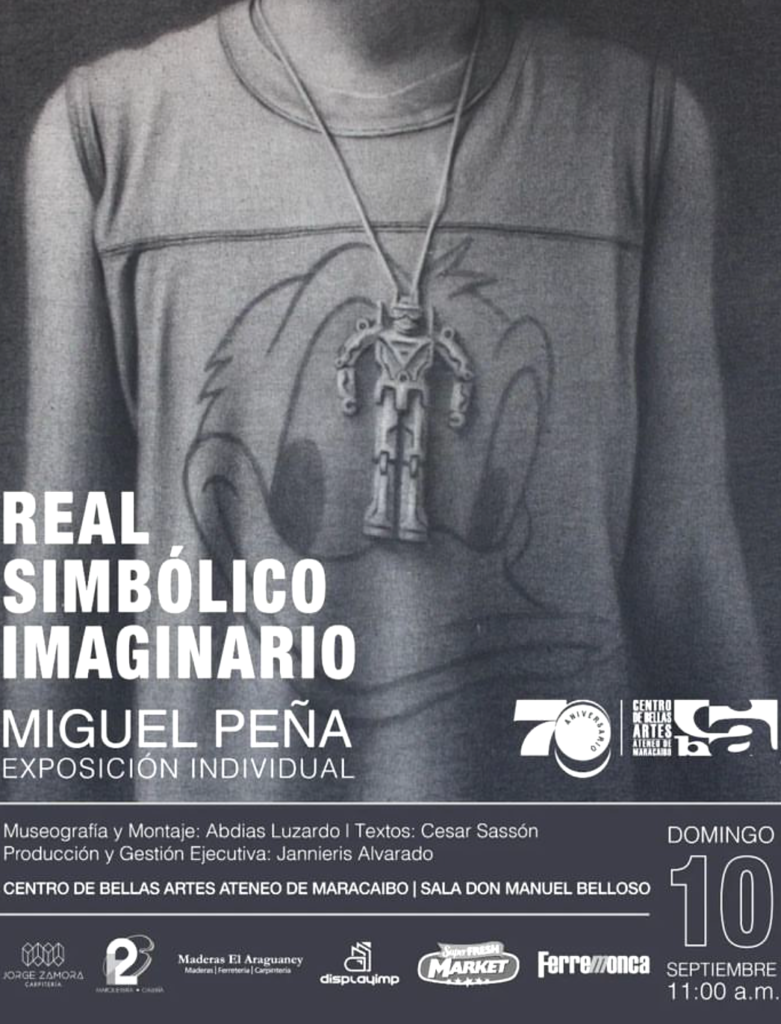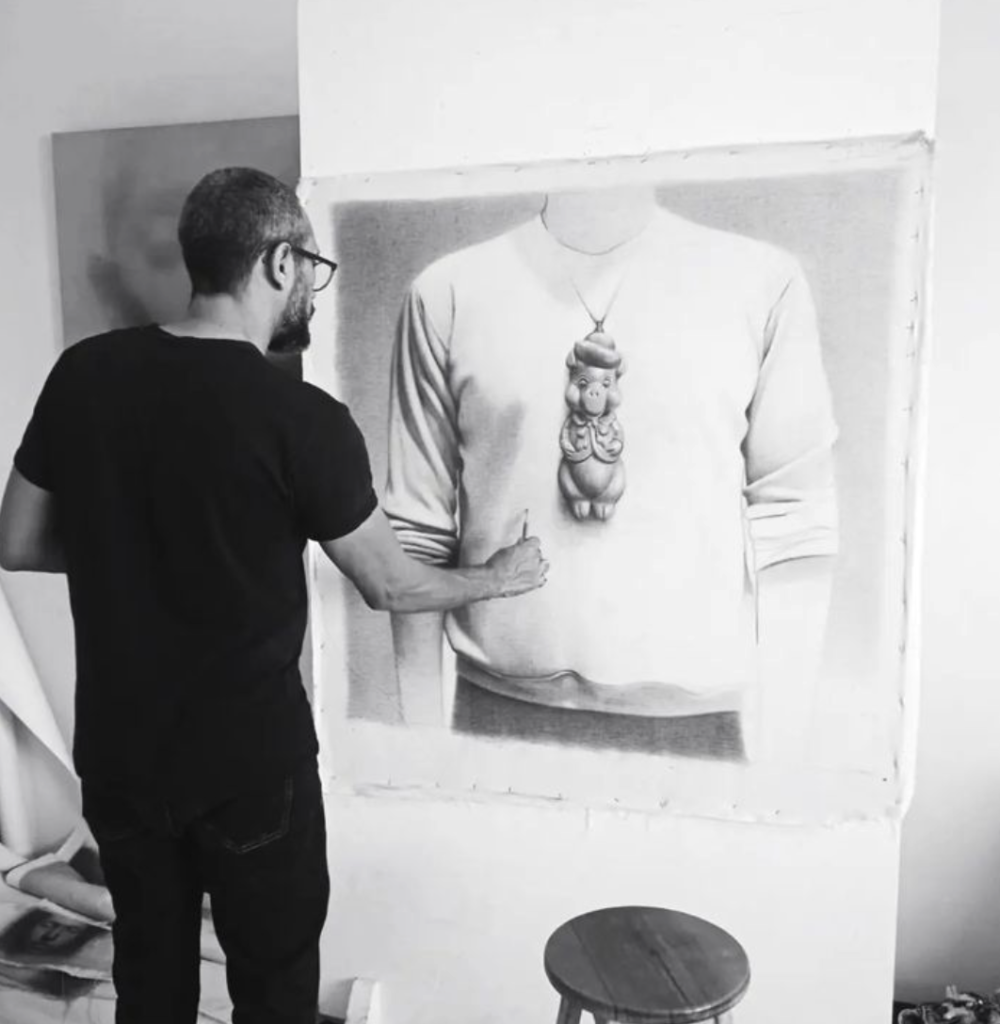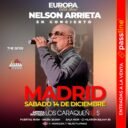MIGUEL PEÑA
REAL, SIMBOLICO, IMAGINARIO
Pareciera que la modernidad se basa en las formas más simples con las que estamos en contacto en nuestro día a día. De hecho, desde la prehistoria, hasta la actualidad, nuestra fascinación por lo simple ha evolucionado a tal grado, que ha permitido la creación de un conjunto de lenguajes universales en torno a ella, que van desde el minimalismo, pasando por el arte poético hasta llegar al espiritualismo hindú, entre muchos otros, que parecen coincidir todos sobre cuál es la forma más sencilla: a saber: el cuerpo humano.
En la actualidad, en un momento en el que los “ismos” parecieran haber desvanecido del escenario artístico para darle paso a un nuevo tipo de expresión, esta vez, sin ningún tipo de limitaciones, ello pudiera tener como consecuencia el confinamiento de algunos artistas a una esquina del plató en solitario, en razón de la creencia de muchas personas de que el arte ya no tiene para donde ir, lo que les ha permitido aferrarse a una idea peregrina de que todo está por acabarse, particularmente en estos tiempos de arte digital e inteligencia artificial.
Afortunadamente, esta creencia carece de fundamento, por cuanto nada termina de manera absoluta, sino, muy por el contrario, simplemente sigue y sigue y sigue, como nos lo demuestra en su más reciente exposición, el joven artista Miguel Peña, quien aferrado a esta premisa sobre la continuidad, se acerca sin temor al centro del escenario, con un conjunto de obras en las que predomina el cuerpo humano; siendo quizás el detalle más notable en ellas, el hecho de que han sido realizadas todas utilizando el medio más primitivo que conocemos: el lápiz; con el cual el artista se ha permitido un regreso al origen ancestral del arte, a pesar de cualquier limitación que este recurso pudiera parecer imponerle, como por ejemplo, el de poder agregar o borrar elementos dentro de sus composiciones con la misma facilidad que se lo permitiría la pintura.
En consecuencia, Miguel Peña, lápiz en mano, ha decidido devolverse al postulado ancestral del artista sentado frente a su modelo para representar exactamente lo que ve, y con ello vencer toda dificultad de capturar cualquier expresión fugaz, en el rostro de ellos, para convertir sus creaciones, realizadas con una destreza singular, no solo en un inmenso desafío técnico sino en un recurso para lograr que cada una de ellas parezca estar intensamente viva.

Las obras de Miguel Peña, además de ser evidentemente composiciones pictóricas, se nos presentan como una construcción poética y narrativa a la vez, en las que el artista ha sabido reunir, de manera exitosa, las tres cualidades que dan nombre a su muestra, a saber: lo REAL, lo SIMBOLICO y lo IMAGINARIO, pero, manteniéndose lejos de la tentación de incorporar a ellos ningún requisito propio del arte contemporáneo, por el contrario, sus dibujos parecen haber sido realizados de forma casi monacal, sin colaboración alguna de la tecnología, y se nos muestran como unos trabajos artesanales y vulnerables a la vez, en los que se nota, sin ambigüedad, un control total sobre ellos por parte de su creador.
En definitiva, se pudiera afirmar que el arte de Miguel Peña es su manera de estar en la escritura sin estarlo, o quizás por el contrario, es su manera de estarlo, pero de manera silenciosa, al haberse limitado al menor número de recursos para su realización, y hacer uso exclusivamente de la mancha negra para cubrir la blanca palidez de sus telas, y crear así, un conjunto de obras monocromáticas que contienen la misma fuerza de cualquier cuadro a color; con los que se permite contarnos sus historias sin tener que recurrir a la página escrita, como lo haría cualquier escritor, y confirmar con ello, la relevancia de estas palabras de Leonardo da Vinci, “La pintura es poesía muda; la poesía, pintura ciega”. Lección que él ha aprendido a cabalidad, al saber perfectamente, que el dibujo y la escritura tienen un ancestro común, por haber nacido ambos como un simple gesto, por lo tanto, para él, dibujar no es más que escribir, pero con un tipo especial de caligrafía, una que le permite a sus dibujos tener todos los elementos de una anotación, que le faculte, el poder dibujar con las manos lo que no puede escribir con ellas, puesto que para él, la escritura al igual que el dibujo, en el fondo no es una realidad, sino apenas una desviación artística de ella.
Lo que me permite citar al escritor francés Pascal Quignard, quien en su libro “El odio a la música”, trata de explorar las maneras de poder sustituir el lenguaje y escribe: “El silencio sin duda fue el que me hizo decidirme a escribir; pude hacer el siguiente trato: estar en el lenguaje callándome”. En la obra de Miguel Peña, el silencio, se nos presenta como un protagonista principal dentro de la composición, pero esta vez, oculto detrás de los ojos cerrados de sus modelos, quienes, para poder ver, han decidido hacerlo abriendo sus corazones, y permitirse de esta manera, ver exclusivamente las cosas importantes que les suceden, ya que no todas, en definitiva, los son. De esta manera, Miguel Peña, busca a través de su “silencio”, procurar en el espectador un estado de reflexión que pudiera elevar ese intercambio silencioso con la obra a un recogimiento que logre llevarlo a un verdadero estado de sublimidad.
Me gustaría finalizar afirmando que vistas en conjunto, las obras de Miguel Peña, parecieran estar todas unidas de manera coherente, como lo puede ser un buen cuento de principio a fin, al demostrarnos como cada una de ellas termina siendo proporcionalmente parte de la otra, y permitirnos apreciar como el artista ha logrado trascender cualquier pregunta trivial, como lo pudiera ser la identidad del retratado, o en su defecto, las referidas a la técnica utilizada para su creación, para conducirnos directamente a una poderosa y conmovedora comprensión de nuestra propia humanidad, y confirmarnos con ello que, en definitiva, estamos frente a un artista de indudable talento, que ha sabido incorporar a sus creaciones, lo mejor de las enseñanzas dejadas por los maestros que lo precedieron, y quien estoy seguro dará mucho de qué hablar en el futuro.

Cesar Sasson
It seems that modernity is based on the simplest forms with which we are in contact in our day to day. In fact, from ancient history to the present, our fascination for the simple has evolved to such a degree that it has allowed us to create a set of universal languages around it, ranging from minimalism, through poetic art, reaching to Hindu spiritualism, among many others, that all seem to agree on which is the simplest form: namely, the human body.
Currently, at a time when «isms» seem to have vanished from the artistic scene to give way to a new type of expression, this time, without any limitations, which could result in the confinement of some artists to a solitary corner of the set, due to the belief of many, that art has no longer anywhere to go, which has allowed them to cling to a strange idea that everything is about to end, particularly in times of digital art and artificial intelligence.
Fortunately, this belief is unfounded, since nothing ends absolutely, but rather, quite the contrary, it just goes on and on and on, as shown in his most recent exhibition by the young artist Miguel Peña, who, clinging to this premise regarding continuity, fearlessly approaches the center of the stage, with a set of works in which the human body predominates; being perhaps the most notable detail in them, the fact that they have all been made using the most primitive medium we know of: the pencil; with which the artist has allowed himself a return to the ancestral origin of art, despite any limitation that this resource might seem to impose upon him, such as being able to add or delete elements within his compositions with the same ease as painting would allow him to.
Consequently, Miguel Peña, pencil in hand, has decided to return to the ancestral postulate of the artist sitting in front of his model to represent exactly what he sees, and thereby overcome all difficulties of capturing any fleeting expression, on their faces, to convert his creations, made with singular skill, not only in an immense technical challenge but also in a device that makes each one of them seem intensely alive.
The works of Miguel Peña, in addition to being obviously pictorial compositions, are presented to us as a poetic and narrative construction at the same time, in which, the artist has managed to successfully combine the three qualities that give his exhibition its name, which are: the REAL, the SYMBOLIC and the IMAGINARY, but, keeping always away from the temptation of incorporating into them any requirement typical of contemporary art, on the contrary, his drawings seem to have been made in an almost monastic way, without any technological collaboration whatsoever, and are shown to us as handmade and vulnerable works at the same time, in which one can unambiguously note total control over them by their creator.
In short, it could be said that the art of Miguel Peña is his way of being in writing without being there, or perhaps on the contrary, it is his way of being there, but silently, by having limited himself to the fewest resources in their realization, and made exclusive use of the black stain to cover the whiteness of his canvases, and thus create a set of monochrome works that contain the same strength as any color painting; that allow themselves to tell us their stories without having to resort to the written page, as any writer would, and thereby confirm the relevance of the following words by Leonardo da Vinci, “Painting is silent poetry; poetry, blind painting”. A lesson that he has fully learned, by knowing perfectly well that drawing and writing have a common ancestor, both were born as a simple gesture, therefore, for him, drawing is nothing more than writing, but with a different calligraphy, one that allows his drawings to have all the elements of a hand note, which empowers him to draw with his hands what he cannot write with them, since for him, writing as well as drawing, deep down are not a reality, but just an artistic deviation from it.
Which allows me to quote French writer Pascal Quignard, who in his book «Hate of Music» tries to explore the ways to replace language and writes: «Silence was undoubtedly what made me decide to write; I was able to make the following deal: be in the language by keeping quiet.” In Miguel Peña’s work, silence is presented to us as a main protagonist within the composition, but this time, hidden behind the closed eyes of his models, who, in order to see, have decided to do so by opening their hearts instead of their eyes, and allow themselves to see exclusively the important things that happen to them, since not all of them, ultimately, are. This way, Miguel Peña seeks through his «silence» to provide the viewer with a state of reflection that could elevate that silent exchange with the work to a recollection that can manage to take him to a true state of sublimity.
I would like to finish by stating that seen as a whole, Miguel Peña’s works seem to be united in a coherent way, as a good story would be from beginning to end, by showing us how each one of them ends up being proportionally part of the other. and allow us to appreciate how the artist has managed to transcend any trivial question, such as the identity of the sitter, or otherwise, those referred to the technique used in their creation, to lead us directly to a powerful and moving understanding of our own humanity, and confirm with it, that, in short, we are facing an artist of undoubted talent, who has known how to incorporate into his creations, the best of the teachings left by the masters who preceded him, and who I am sure will give a lot to talk about in the future.
Cesar Sasson
Panama City, August 2023







